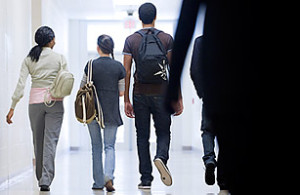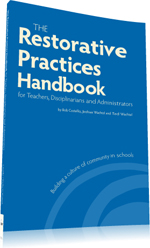News & Announcements
- Details
- Written by Joshua Wachtel
For your reading pleasure, we now have the following titles available in Amazon Kindle, Apple iBooks and Barnes & Noble Nook formats, for instant delivery and all priced at just under ten US dollars.
The Restorative Practices Handbook An introduction and guide to restorative practices covering practical techniques, tips and strategies, implementation guidelines and real-world stories of restorative practices in action.
- Details
- Written by Joshua Wachtel
 from the Patiot-News fileThis story from the Harrisburg Patriot-News by M. Diane McCormick discusses Susquehanna Township's decision to adopt IIRP's Whole School Change Program and quotes IIRP trainer Steve Korr:
from the Patiot-News fileThis story from the Harrisburg Patriot-News by M. Diane McCormick discusses Susquehanna Township's decision to adopt IIRP's Whole School Change Program and quotes IIRP trainer Steve Korr:
In a climate marked by parents’ vocal concerns about bullying and school discipline, Susquehanna Township School District adopted a program meant to build personal connections that minimize in-school confrontations and disruptions.
In April, a district mother asked the school board to review its bullying policies because her daughter had missed four days of school because of bullying. On May 9, a special school board meeting on school discipline — a meeting notable for shouting matches among board members, according to reports — drew parents who said their children are being or have been bullied.
- Details
- Written by Joshua Wachtel
 Getty Images, posted at Time.comAn article called "Do 'Zero Tolerance' School Discipline Policies Go Too Far?" by Sarah Carr of the Hechinger Report appeared at Time.com last week. On page 4 of the 6 page story there was this discussion about City Springs Elementary-Middle School in Baltimore, Maryland, where IIRP has worked extensively:
Getty Images, posted at Time.comAn article called "Do 'Zero Tolerance' School Discipline Policies Go Too Far?" by Sarah Carr of the Hechinger Report appeared at Time.com last week. On page 4 of the 6 page story there was this discussion about City Springs Elementary-Middle School in Baltimore, Maryland, where IIRP has worked extensively:
At City Springs Elementary-Middle School, Alonso's push coincided with Principal Rhonda Richetta's decision to introduce a "restorative justice" approach to school discipline: instead of automatically suspending students when there is a problem, staff and students sit together in circles to talk through many thorny and contentious issues. Often, the end result is a punishment tailored to the specific crime.
- Details
- Written by Joshua Wachtel
 The San Francisco Unified School District Restorative Practices Team recently issued a newsletter looking at their experience changing school climate with restorative practices. Included are some statistics of the number of people they've trained along with staff testimonials. Included is a short interview with principal Paul Jacobsen at Rosa Parks Elementary School, which is currently in Year One implementation as a Restorative Practices Demonstration School.
The San Francisco Unified School District Restorative Practices Team recently issued a newsletter looking at their experience changing school climate with restorative practices. Included are some statistics of the number of people they've trained along with staff testimonials. Included is a short interview with principal Paul Jacobsen at Rosa Parks Elementary School, which is currently in Year One implementation as a Restorative Practices Demonstration School.
- Details
- Written by Joshua Wachtel
Are you interested in creating a culture of community and connection on your campus? What tools can be used to live out the mission and values of your university actively every day? How can you engage students in addressing decisions they make as opportunities to learn? What is Restorative Justice (RJ) and how can you bring the principles and tools of RJ to your campus? This manual was developed to help answer these questions and provide a framework to bring restorative justice to your Institution of Higher Education. This framework is based on the impressive Restorative Justice work that is being led by Administrators and RJ Practitioners utilizing RJ principles and tools at 9 prestigious colleges and universities across the United States.
- Details
- Written by Laura Mirsky

A new book from ASCD Publications, How to Create a Culture of Achievement in Your School and Classroom, by Douglas Fisher, Nancy Frey and Ian Pumpian, includes a section on restorative practices, largely informed by the IIRP book, The Restorative Practices Handbook for Teachers, Disciplinarians and Administrators.
- Details
- Written by Joshua Wachtel
 Image from collegemagazine.com courtesy of nativeamericanministry.comHere's a piece by Kristi Eaton of the Associated Press from Pine Ridge, South Dakota. According to the story, the first circle has been convened for a youth case with hopes to continue and broaden the program. Note in the second paragraph that victims and relatives of victims and the offender are included in the process:
Image from collegemagazine.com courtesy of nativeamericanministry.comHere's a piece by Kristi Eaton of the Associated Press from Pine Ridge, South Dakota. According to the story, the first circle has been convened for a youth case with hopes to continue and broaden the program. Note in the second paragraph that victims and relatives of victims and the offender are included in the process:
A South Dakota tribe has been testing a form of restorative justice called sentencing circles in hopes it will make community members more accountable to each other and reduce the number of people who commit more crimes.
- Details
- Written by Joshua Wachtel
- Details
- Written by Joshua Wachtel
From Minnesota Department of Education describes how principals use restorative discipline practices | Twin Cities Daily Planet comes this rather striking statement about a survey conducted in the state:
"The survey was completed by 417 Minnesota principals, of whom 66 percent reported using restorative methods in response to some behavior problems."
And then there this quote by Nancy Riestenberg:
“Students have to be held accountable for making mistakes,” Riestenberg said. “If you don’t give them the opportunity to wipe up their own milk that they spilled, you’re robbing them of the responsibility to learn that they can make a mistake, and they can fix it.”She said suspensions can actually increase incidences of bullying. They can lead to lowered academic achievement and decreased attendance. “The suspensions ended up making them feel so disconnected they didn’t want to come anymore,” she said.
- Details
- Written by Joshua Wachtel
Two letters tell the story. This was posted Monday, May 7, 2012 in the Upper Rogue Independent, without a byline:
One of the programs that we administer in partnership with the Jackson County Juvenile Department is called the Victim Assistance, Youth Accountability (VAYA) program. This program is rooted in the principles of restorative justice - a community response to crime that focuses on addressing the harms done to victims and communities by holding offenders meaningfully accountable for their offenses. According to Cara Walsh, Director of Restorative Justice Programs for Mediation Works. We recognize that crime is more than just a violation against the law and state, but also a violation of people and relationships. Thus, our role in the community is to support youth in being accountable for the harms they caused, provide supportive services to victims of crime, and engage the community in this process, said Walsh.

Restorative Works Year in Review 2023 (PDF)
All our donors are acknowledged annually in Restorative Works.


